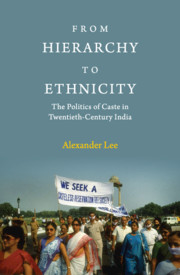Book contents
- Frontmatter
- Dedication
- Contents
- List of Tables
- List of Figures
- Acknowledgements
- 1 Introduction
- 2 Explaining Identity Activism
- 3 Caste in Historical Context
- 4 Caste in the Census of India
- 5 The Causes of Ranked Rhetoric
- 6 Caste since Independence
- 7 Conclusion
- Appendix A Data
- Appendix B Statisical Tests
- Appendix C Additional Tables and Figures
- Bibliography
- Index
Appendix A - Data
Published online by Cambridge University Press: 14 January 2020
- Frontmatter
- Dedication
- Contents
- List of Tables
- List of Figures
- Acknowledgements
- 1 Introduction
- 2 Explaining Identity Activism
- 3 Caste in Historical Context
- 4 Caste in the Census of India
- 5 The Causes of Ranked Rhetoric
- 6 Caste since Independence
- 7 Conclusion
- Appendix A Data
- Appendix B Statisical Tests
- Appendix C Additional Tables and Figures
- Bibliography
- Index
Summary
Measurement
The unit of analysis
The unit of analysis is caste-province-year, but both ‘province’ and ‘caste’ require some explanation. Colonial India was divided into areas ruled by the British government and areas in which sovereignty was delegated to native princes, usually descendants of early British allies. The directly ruled areas were divided into fairly large provinces, of which the most important were: the United Provinces, Bengal, Bihar and Orissa, Bombay, Madras, Punjab, the Central Provinces and Berar, and Assam. Four very small provinces (two of which are overwhelmingly Muslim border areas) have been ignored.
The indirectly ruled areas were divided into three main groups: four large states (Jammu and Kashmir, Hyderabad, Mysore, and Baroda) that enjoyed a direct relationship with the central government, two large groups of states (the Rajputana Agency and the Central Indian Agency) which reported to a political agent appointed by the central government, and a large number of states who reported to the political department of the local British province. The policy followed here has been to report the large states and agencies separately, as the equivalent of British provinces, and include the other states with the province that controlled them. The only exception to this was the large princely state of Travancore, which published its own census report and has been treated as separate from Madras.
There were several changes to provincial boundaries during this period, so I have consolidated provinces to keep the unit of analysis consistent. For the 1891 and 1901 census years, Berar has been treated as part of the Central Provinces even though it was in fact independent, and for the same years, Bihar has been treated separately even though it was in fact part of Bengal. In 1931, the recently created Western Indian States Agency is treated as part of Bombay, and for 1911, 1921, and 1931, Gwalior state is treated as part of the Central Indian Agency.
Two major challenges in the collection of the data were the multiplicity of small castes in India and the large number of alternative names (and alternative spellings) for castes in different areas. The census superintendents generally tried to keep jatis separate, but at times they differed as to what constituted an independent jati (Conlon 1981).
- Type
- Chapter
- Information
- From Hierarchy to EthnicityThe Politics of Caste in Twentieth-Century India, pp. 185 - 190Publisher: Cambridge University PressPrint publication year: 2020



